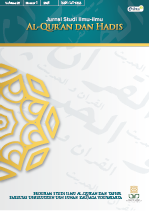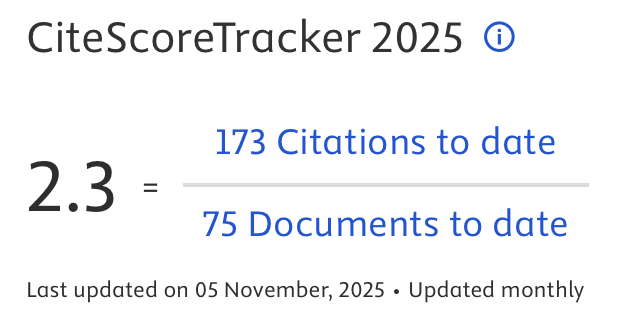PROGRESIVE QUR’ANIC STUDIES IN INDONESIAN STATE ISLAMIC HIGHER EDUCATION (2014-2019): IMPLEMENTATION AND DEVELOPMENT
DOI:
https://doi.org/10.14421/qh.2021.2201-06Keywords:
progressive exegesis, frequency, issues, development and orientation of the studyAbstract
This article describes the state of progressive Qur'anic interpretation studies over the past five years at three State Islamic Higher Education, UIN Ar-Raniry Banda Aceh, UIN Imam Bonjol Padang and UIN Sultan Syarif Kasim Riau. The article is based on the argument that the study of the progressive interpretation of the Qur'an which is reflected in the issues of social justice, women and gender equality, pluralism, and deradicalization has strong relevance to contemporary issues that are widely discussed by scholars. In addition, it is also the responsibility of Islamic higher education to provide Qur'anic solutions to the contemporary problems. The study focused on three questions, namely: the frequency of progressive interpretation studies, the concentration of progressive interpretation issues, and the development and orientation of progressive interpretation studies. The method used in this study is a literature review of the scientific publications of lecturers in the study of the Koran and the final papers of students majoring in Al-Qur'an and Tafsir. The results showed that the study frequency of progressive Qur'anic interpretation in the three universities in the period 2014 – 2019 was still low, recorded at 18.52%. However, the frequency of progressive Qur'anic studies in the 2014-2019 period showed an increase of 1.3%. The issues discussed have covered the four issues mentioned above, although some of them have not received enough attention. The orientation of the study is still concentrated on the interpretation of the meaning of the Koran, it has not yet led to a methodological study in building a paradigm and approach to contemporary interpretation.
Keywords: progressive exegesis; frequency; issues; development and orientation of the study
 Abstract viewed: 830 times
|
Abstract viewed: 830 times
|
 PDF downloaded = 886 times
PDF downloaded = 886 times
References
A.W, Muh. Fathoni Hasyim dan Liliek Channa. “Pemetaan Kajian Tafsir Alquran Pada Pascasarjana Tiga Universitas Islam Negeri (Laporan Penelitian).” Surabaya, 2019.
BAHRI, SAMSUL. “WAWASAN AL QURAN TENTANG PEMBERANTASAN KORUPSI.” Ar-Raniry, International Journal of Islamic Studies Vol. 4, no. No. 2, December (2017): 337–56.
Baidan, Nashruddin. “Paradigma Baru Pengajaran Tafsir Pada IAIN Dan STAIN.” In Hermeneutika Alqur’an Mazhab Yogya. Yogyakarta: Islamica, 2003.
———. Perkembangan Tafsir Al-Qur’an Di Indonesia. Solo: Tiga Serangkai Mandiri, 2003.
Barlas, Asma. “Believing” Women in Islam: Unreading Patriachal Interpretetion of the Qur’an. Austin: University of Texas Press, 2002.
Faizin. “DISKURSUS PENAFSIRAN AYAT PENCIPTAAN PEREMPUAN DALAM JURNAL ILMIAH DI INDONESIA.” Jurnal Ulunnuha Vol.7, no. No.1/Juli (2018): 1–18.
Federspiel, Howard. Kajian Al-Quran Di Indonesia (Dari Mahmud Yunus Hingga Quraish Shihab). Bandung: Mizan, 1996.
Gusmian, Islah. Khazanah Tafsir Indonesia, Dari Hermeneutika Hingga Ideologi. Jakarta: Teraju, 2003.
———. “Paradigma Penelitian Tafsir Al-Qur’an Di Indonesia.” Empirisma Vol. 24, no. No. 1 (2015): 1–10.
Iskandar, Nuzul. “KEKUATAN PEREMPUAN DALAM AYAT-AYAT HUKUM KEWARISAN.” Kafa’ah : Jurnal Ilmiah Kajian Gender Vol.V, no. No.2 (2015): 219–38.
Ismail, Nurjannah. “REKONSTRUKSI TAFSIR PEREMPUAN: MEMBANGUN TAFSIR BERKEADILAN GENDER (Studi Kritis Atas Pemikiran Asghar Ali Engineer, Fatima Mernissi Dan Amina Wadud Muhshin Tentang Perempuan Dalam Islam).” Gender Equality: Internasional Journal of Child and Gender Studies Vol. 1, no. No. 1, Maret (2015): 39–50.
Jamarudin, Ade. “MEMBANGUN TASAMUH KEBERAGAMAAN DALAM PERSPEKTIF AL-QUR’AN.” TOLERANSI: Media Komunikasi Umat Beragama Vol. 8, no. No. 2, Juli – Desember (2016): 170–87.
———. “SOCIAL APPROACH IN TAFSIR AL-QUR’AN PERSPECTIVE OF HASAN HANAFI.” JURNAL USHULUDDIN Vol. 23, no. No. 1, Juni (2015): 1–16.
Khairunnas Jamal, Nasrul Fatah, dan Wilaela. “EKSISTENSI KAUM DIFABEL DALAM PERSPEKTIF AL-QUR’AN.” Jurnal Ushuluddin Vol. 25, no. No.2, Juli-Desember (2017): 221–34.
Latif, Hamdiah A. “KESAKSIAN DUA PEREMPUAN DALAM AL-QURAN: STUDI KOMPARATIF KITAB TAFSIR.” Jurnal Ilmiah Al-Mu’ashirah Vol 15, no. No 2 (2018): 122–31.
M. Isa HA Salam dan Rifqi Muhammad Fathi. “Pemetaan Kajian Tafsir Alquran Pada Program Pascasarjana UIN Syarif Hidayatullah Jakarta Dan UIN Sunan Kalijaga Yogyakarta; Analisis Sitiran Pengarang Yang Disitir Disertasi Mahasiswa Tahun 2005 – 2010 (Laporan Penelitian Kolektif).” Jakarta, 2015.
Mursyid, Achmad Yafik. “Deturkifikasi Dalam Tafsir Hak Dini, Kur’an Dili Karya Elmalili Hamdi Yazir.” Jurnal Studi Ilmu-Ilmu Al-Qur’an Dan Hadis, 2020. https://doi.org/10.14421/qh.2020.2101-06.
Mustaqim, Abdul. “Argumentasi Keniscayaan Tafsir Maqasidi Sebagai Basis Moderasi Islam.” Yogyakarta: Univesitas Sunan Kaijaga, 2019.
Nasaruddin Umar. Deradikalisasi Pemahaman AL-Qur’an & Hadis. Jakarta: Kompas - Gramedia, 2014.
Rahmi. “POLIGAMI : PENAFSIRAN SURAT AN NISA’ AYAT 3.” Kafa’ah : Jurnal Ilmiah Kajian Gender Vol. V, no. No.1 (2015): 116–28.
Roifa, Rifa. “Perkembangan Tafsir Di Indonesia (Pra Kemerdekaan 1900-1945).” Al-Bayan: Jurnal Studi Al-Qur’an Dan Tafsir Vol. 2, no. No. 1 (2017): 21–36.
Saeed, Abdullah. Interpreting the Qur’an: Towards a Contemporary Approach. Abingdon & New York: Routledge, 2006.
———. Reading the Qur’an in the Twenty-First Century A Contextualist Approac. New York: Routledge, 2014.
Setiawan, M. Nur Kholis. Akar-Akar Pemikiran Progresif Dalam Kajian Al-Qur’an. Yogyakarta: Elsaq Press, 2008.
———. Pribumisasi Al-Qur’an: Tafsir Berwawasan KeIndonesiaan. Yogyakarta: Kaukaba, 2012.
Subhan, Zaitunah. Tafsir Kebencian : Studi Bias Gender Dalam Tafsir Qur’an. Yogyakarta: LKiS, 1999.
Syahrur, Muhammad. Al-Kitab Wa Al-Qur’an: Qia’ah Mu’ashirah. Damaskus: Al-Ahali li Al-Tiba’ah wa al-Nasyr wa al-Tauzi’, 1990.
Taufikurrahman. “Kajian Tafsir Di Indonesia.” Mutawâtir: Jurnal Keilmuan Tafsir Hadis Volume 2, no. Nomor 1 (2012): 1–26.
Yasir, Afriadi Putra dan Muhammad. “Kajian Al-Qur’an Di Indonesia (Dari Studi Teks Ke Living Qur’an.” Majalah Ilmu Pengetahuan Dan Pemikiran Keagamaan Tajdid Vol 21, no. No 2 (2018): 13–22.
Zaiyadi, Ahmad. “Lokalitas Tafsir Nusantara, Dinamika Studi Alquran Di Indonesia.” Al-Bayan: Jurnal Ilmu Al-Qur’an Dan Hadits Vol. 1, no. No. 1 Januari, (2018): 1–26.
Zulaikha, Eni. “Tafsir Kontemporer: Metodologi, Paradigma Dan Standar Validitasnya.” Wawasan: Jurnal Ilmiah Agama Dan Sosial Budaya 2, no. 1 (Juni) (2017).
Downloads
Published
How to Cite
Issue
Section
License
Publishing your paper with Jurnal Studi Ilmu-ilmu al-Qur'an dan Hadis means that the author or authors retain the copyright in the paper. Jurnal Studi Ilmu-ilmu al-Qur'an dan Hadis uses license CC-BY-NC-ND or an equivalent license as the optimal license for the publication, distribution, use, and reuse of scholarly works. This license permits anyone to copy and redistribute the material in any medium or format and must give appropriate credit, provide a link to the license, and indicate if changes were made. If you remix, translate, transform or build upon the material you may use it for private use only and not for distribution. Jurnal Studi Ilmu-ilmu al-Qur'an dan Hadis granted an exclusive non-commercial reuse license by the author(s), but the author(s) are able to put the paper onto a website, distribute it to colleagues, give it to students, use it in your thesis, etc, so long as the use is not directed at a commercial advantage or toward private monetary gain. The author(s) can reuse the figures and tables and other information contained in their paper published by Jurnal Studi Ilmu-ilmu al-Qur'an dan Hadis in future papers or work without having to ask anyone for permission, provided that the figures, tables, or other information that is included in the new paper or work properly references the published paper as the source of the figures, tables or other information, and the new paper or work is not direct at a private monetary gain or commercial advantage.
Jurnal Studi Ilmu-ilmu al-Qur'an dan Hadis journal Open Acces articles are distrubuted under the Creative Commons Attribution-NonCommercial-NoDerivatives 4.0 International (CC BY-NC-ND 4.0). Article can be read, copy and redistribute the material ini any medium or format under the following conditions:
Attribution — You must give appropriate credit, provide a link to the license, and indicate if changes were made. You may do so in any reasonable manner, but not in any way that suggests the licensor endorses you or your use.
NonCommercial — You may not use the material for commercial purposes.
NoDerivatives — If you remix, transform, or build upon the material, you may not distribute the modified material.










